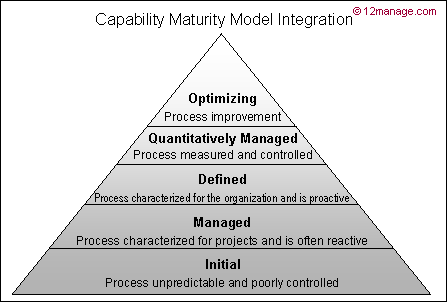Capability Maturity Model
CMM, short for Capability Maturity Model is a process improvement technique for evaluating how efficiently a company is able to deliver technology products to its customers. Therefore, Capability Maturity Model offers a framework for evolutionary process improvement.
In other words, being a registered service mark of Carnegie Mellon University, Capability Maturity Model is a development model that was created after study of data collected from organizations that contracted with the U.S Department of Defense, who founded the research. “Maturity” is the term that relates to the degree of formality and optimization of processes, from ad hoc practices, to formally distinct steps, to managed result metrics, to active optimization of the processes.
Originally applied to software development, it has been expanded to cover other areas including Human Resources and Software Acquitition.
When the Capability Maturity Model is applied to existing software development processes of an organization, an efficient and successful approach toward improving these processes is therefore allowed. Eventually, it is clear that this model could be applied to other processes. In this way, a more general concept that is applied to business is thus arisen.
A maturity model can be viewed as a set of structured levels describing how well the behaviors, practices and processes of an organization can produce required outcomes in a reliable and sustainable way.
So, a maturity model can be used as a point of reference for comparison and as an aid to understanding, for example for comparative assessment of different organizations where there is something in common that can be used as a basis for comparison. In the case of the Capability Maturity Model, the basis for comparison would be the organization’s software development processes.
The five most important levels that are involved in the Capability Maturity Model are as follows:
- Initial (chaotic, ad hoc, individual heroics): This the starting point for use of a new or undocumented repeat process. It is characteristic of processes at this level that they are typically in a non-documented state and in a state of dynamic change, tending to be driven in an ad hoc, uncontrolled and reactive manner by users or events. This provides a chaotic or unstable environment for the processes.
- Repeatable: The process is at least documented sufficiently such that repeating the same steps may be attempted. At this level some processes are repeatable, possibly with consistent results. Process discipline is unlikely to be rigorous, but where it exists it may help to ensure that existing processes are maintained during times of stress.
- Defined: the process is defined or confirmed as a standard business process, and decomposed to levels 0, 1 and 2 (the latter being work instructions). There are sets of defined and documented standard processes established and subject to some degree of improvement over time. These standard processes are in place and are used to set up consistency of process performance across the organization.
- Managed: The process is quantitatively managed in accordance with agreed-upon metrics. By making use of metrics, management can effectively control the processes involved in the development, like for software development. In particular, management can spot ways to fine-tune and adapt the processes to particular projects without measurable losses of quality or deviations from specifications or requirements. Process capability is thus set at this level of the Capability Maturity Model.
- Optimizing: the focus of this level is mainly on continually improving process performance through both incremental and innovative technological changes and improvements.
The processes of the level 5 of the Capability Maturity Model are mostly concerned with statistical common causes of process variation and changing the process, for example to shift the mean of the process performance, to improve process performance. This would be done at the same time as maintaining the likelihood of achieving the established quantitative process-improvement objectives.
Capability Maturity Model - CMM




